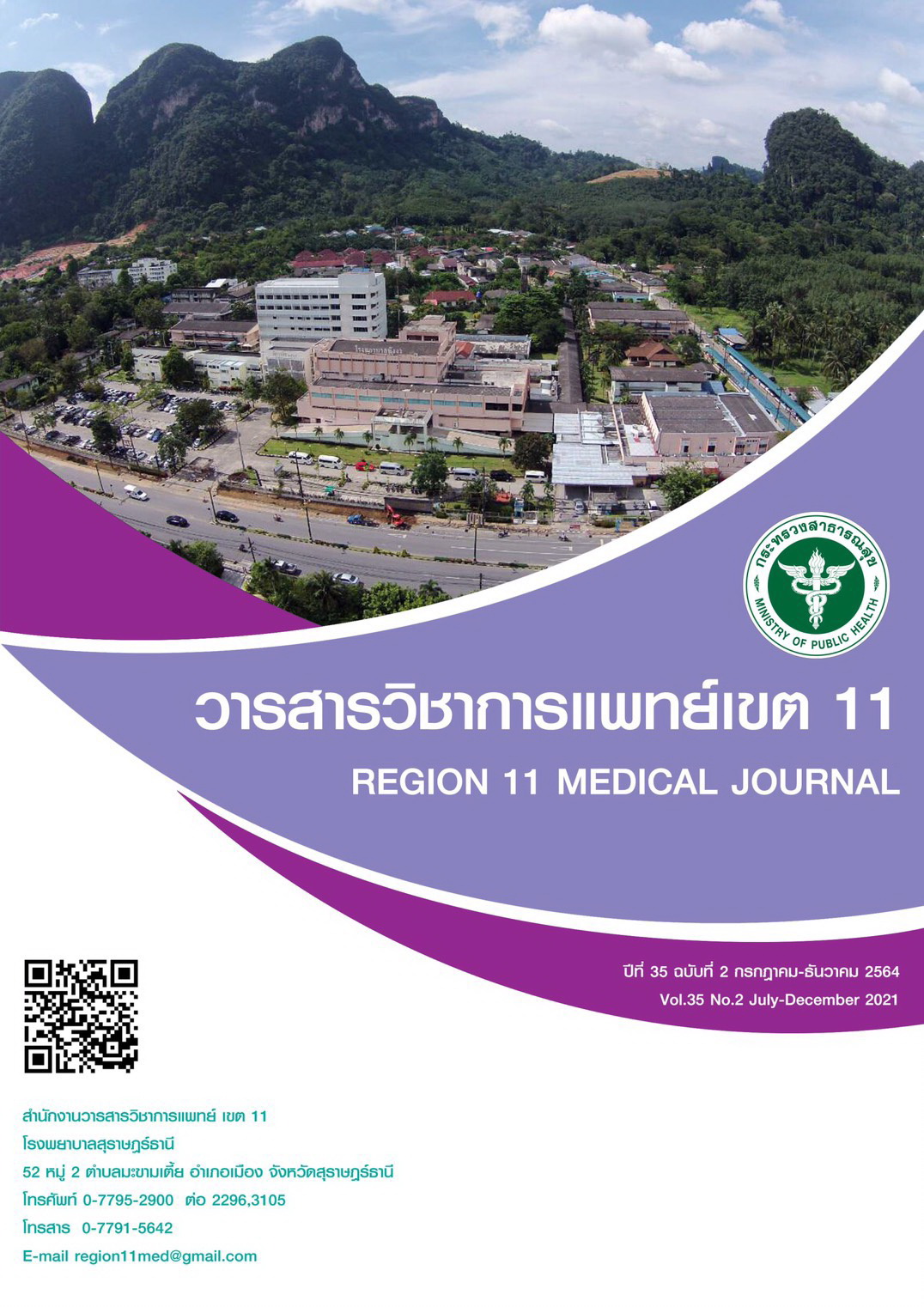SAR-CoV-2 specific antibody detection among heath care workers with direct contact to COVID-19 patients in Vachira Phuket Hospital
Keywords:
Healthcare workers, Coronavirus Disease 2019 (COVID-19), AntibodyAbstract
Background: The main cause of the COVID-19 outbreak is transmission from asymptomatic patients. Healthcare workers are high risk groups who were likely to be infected. The personnel were randomly assigned to screen for COVID-19 using RT-PCR technique but has never tested for the SAR-CoV-2 IgG antibody for seroprevalence surveys
Objectives: To determined the seroprevalence of COVID-19 among healthcare workers at Vachira Phuket hospital and the effectiveness of hospital infection measures
Method: This was a prospective cross-sectional study. Both general information, history of illness, screening for COVID-19 results and adherence to hospital precautions against infection data has been brought to analyze the classification of high and low risk groups. The SAR-CoV-2 IgG antibody was examined and analyzed for risk factors affected to the detection of antibodies
Result: SAR-CoV-2 IgG antibodies were found in only 1.67% of personnel and were more common in those who did not work with COVID-19 (low-risk) patients, consistent with the results of the assessment in compliance with preventive measures of the hospital. Because the workers dealing directly with COVID-19 patients (high-risk groups) had a statistically significantly higher frequency of wearing personal protective equipment (PPE) and disinfecting contaminated personal equipment. This prevents infection from working while low-risk groups are likely to get the infection from patients who do not show symptoms because the protective equipment is not used properly
Conclusion: Personnel should follow preventive measures for infection in all the time because there is a chance to get infection from patients who do not show symptoms
References
World Health Organization. Coronavirus disease (COVID-19) Pandemic [Internet]. 2019 [cited 2020 Aug 12]. Available from:https://www.who.int/emergencies/diseases/novel-corona virus-2019
Huang C, Wang Y, Li X, Ren L, Zhao J, Hu Y, et al. Clinical features of patients infected with 2019 novel coronavirus in Wuhan, China. Lancet 2020;95:497-506.
Guan W-j, Ni Z-y, Hu Y, Liang W-h, Ou C-q, He J-x, et al. Clinical characteristics of coronavirus disease 2019 in China. New England journal of medicine. 2020;382(18):1708-20.
Johansson MA, Quandelacy TM, Kada S, Prasad PV, Steele M, Brooks JT, et al. SARS-CoV-2 transmission from people without COVID-19 symptoms. JAMA network open. 2021;4(1):e2035057-e.
Baggett TP, Keyes H, Sporn N, Gaeta JM. Prevalence of SARS-CoV-2 infection in residents of a large homeless shelter in Boston. Jama. 2020;323(21):2191-2.
Sakurai A, Kato S, Hayashi M, Ishihara T, Iwata M, Morise Z, et al. Natural history of asymptomatic SAR-CoV-2 infection. New England Journal of Medicine. 2020;383:885-6.
Center for Disease Control and Prevention. Interim Guidelines for COVID-19 Antibody Testing [Internet]. 2020 [cited 2021 Jan 10]. Available from: https://www.cdc.gov/coronavirus/2019-ncov/lab/resources/antibody-tests-guidelines.html.
Liu W, Liu L, Kou G, Zheng Y, Ding Y, Ni W, et al. Evaluation of nucleocapsid and spike protein-based enzyme-linked immunosorbent assays for detecting antibodies against SARS-CoV-2. Journal of clinical microbiology. 2020;58(6):e00461-20.
Korth J, Wilde B, Dolff S, Anastasiou OE, Krawczyk A, Jahn M, et al. SARS-CoV-2-specific antibody detection in healthcare workers in Germany with direct contact to COVID-19 patients. Journal of Clinical Virology. 2020;128:104437.
Iversen K, Bundgaard H, Hasselbalch RB, Kristensen JH, Nielsen PB, Pries-Heje M, et al. Risk of COVID-19 in health-care workers in Denmark: an observational cohort study. The Lancet Infectious Diseases. 2020;20(12):1401-8.
Moscola J, Sembajwe G, Jarrett M, Farber B, Chang T, McGinn T, et al. Prevalence of SARS-CoV-2 antibodies in health care personnel in the New York City area. Jama. 2020;324(9):893-5.
Wu F, Wang A, Liu M, Wang Q, Chen J, Xia S, et al. Neutralizing antibody responses to SARS-CoV-2 in a COVID-19 recovered patient cohort and their implications. 2020.
Sethuraman N, Jeremiah SS, Ryo A. Interpreting diagnostic tests for SARS-CoV-2. Jama. 2020;323(22):2249-51.
Zhao J, Yuan Q, Wang H, Liu W, Liao X, Su Y, et al. Antibody responses to SARS-CoV-2 in patients with novel coronavirus disease 2019. Clinical infectious diseases. 2020;71(16):2027-34.
Long Q-X, Tang X-J, Shi Q-L, Li Q, Deng H-J, Yuan J, et al. Clinical and immunological assessment of asymptomatic SARS-CoV-2 infections. Nature medicine. 2020;26(8):1200-4.
Lumley SF, O’Donnell D, Stoesser NE, Matthews PC, Howarth A, Hatch SB, et al. Antibody status and incidence of SARS-CoV-2 infection in health care workers. New England Journal of Medicine. 2021;384(6):533-40.
Polack FP, Thomas SJ, Kitchin N, Absalon J, Gurtman A, Lockhart S, et al. Safety and efficacy of the BNT162b2 mRNA Covid-19 vaccine. New England Journal of Medicine. 2020.
Voysey M, Clemens SAC, Madhi SA, Weckx LY, Folegatti PM, Aley PK, et al. Safety and efficacy of the ChAdOx1 nCoV-19 vaccine (AZD1222) against SARS-CoV-2: an interim analysis of four randomised controlled trials in Brazil, South Africa, and the UK. The Lancet. 2021;397(10269):99-111.
Al Kaabi N, Zhang Y, Xia S, Yang Y, Al Qahtani MM, Abdulrazzaq N, et al. Effect of 2 Inactivated SARS-CoV-2 Vaccines on Symptomatic COVID-19 Infection in Adults: A Randomized Clinical Trial. Jama. 2021






